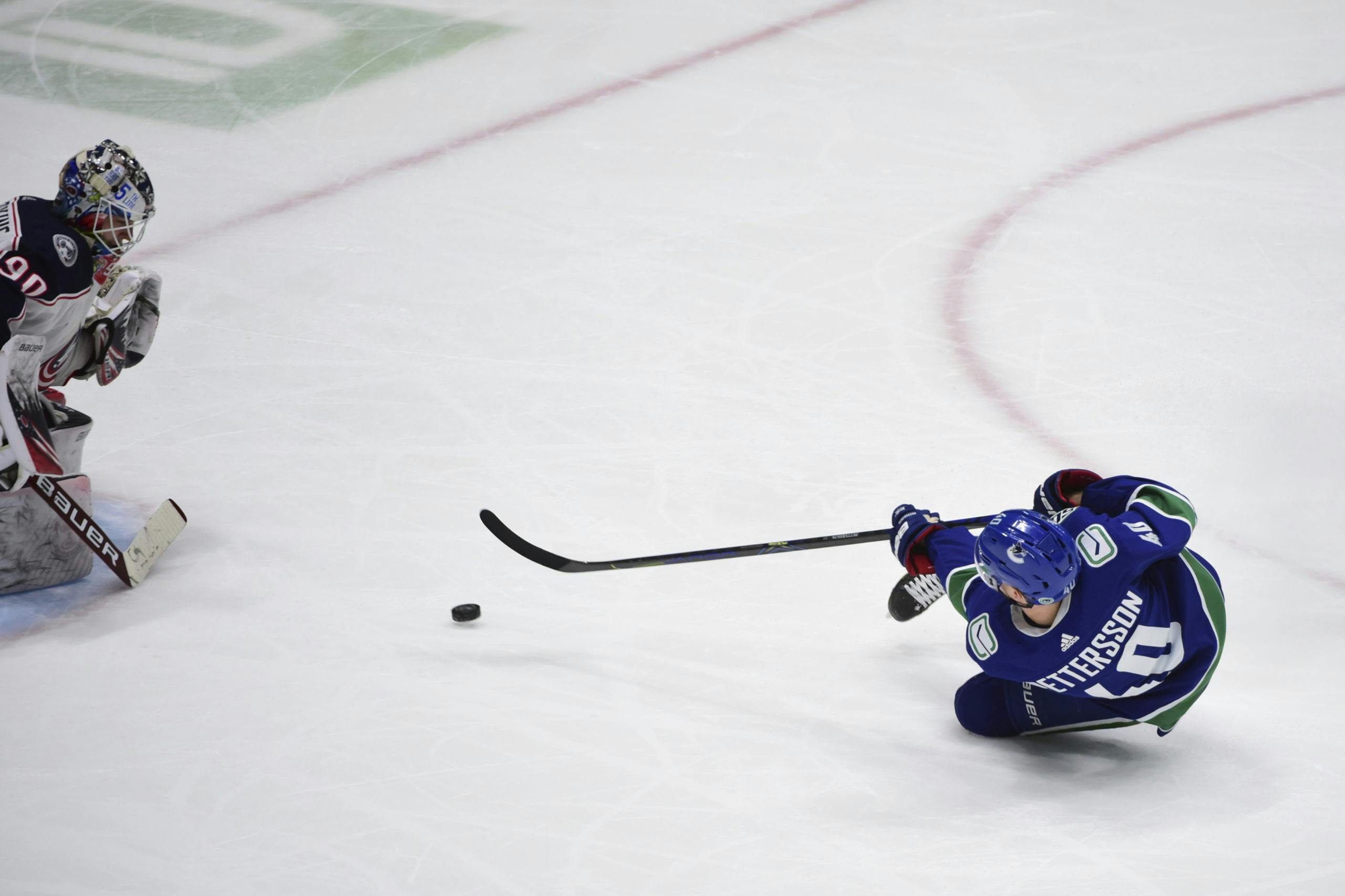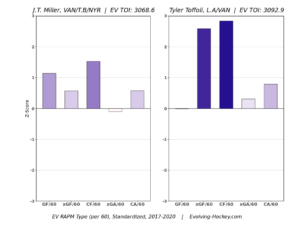The Tape: Is Elias Pettersson Ready to Matchup Against Top Lines? (Part 2)

By Brett Lee
4 years agoWith the NHL season on hold, hockey fans have been left with more questions than answers. The return of NHL hockey looks further away than ever, which leaves us with plenty of time to speculate on what those answers might be.
As I explored a couple of weeks ago, one question that’s on the mind of every Canucks fan is where Elias Pettersson is at in his development, and whether or not it’s time for Elias Pettersson to go toe to toe against other teams’ top lines.
The question arose due to a number of factors impacting the Canucks as they were making their playoff push in early March. With two wins in their last seven games and an injury in goal to Vezina candidate Jacob Markstrom, Vancouver would need their best players to be their best players down the stretch.
In case you missed part one of this series, I covered the individual traits of Elias Pettersson’s game that make him suited for a larger defensive role here.
In this second part of this series, we’ll be taking a look at Pettersson’s wingers and how they defend against zone pressure as a unit.
Quality of Teammates
Matching up against Sidney Crosby or Alex Ovechkin requires a group effort to effectively shut them down and Elias Pettersson is flanked by two defensively reliable wingers in Tyler Toffoli and J.T. Miller.

Both wingers have profiled well offensively over the past three seasons, but they’ve also been above-average in shot suppression according to Evolving-Hockey’s RAPM metrics.
J.T. Miller brings many defensive perks to Petterson’s wing, as he can also play centre. This has been most notable in the faceoff circle, where Miller has subbed in for Pettersson with great success. He won 59.2% of his draws this season, which is good for second in the league. The secondary benefit is that he is comfortable assuming the defensive duties of the F1 which is what a centre usually is tasked with. I have already covered the defensive responsibilities of F1, F2, and F3 in part one of this series but to recap, the F1’s main responsibility in their own zone is to provide puck side support for his defenceman. Below is a great example of Miller carrying out his F1 duties. Coming all the way back to the top of his crease, supporting his defencemen in front of the net, Miller finds the puck bouncing towards the corner. This highlights another strength of Miller’s toolset as he has the size to physically engage in the corners and help win back pucks as he does in this play.
I touched on Toffoli’s sound two-way play when Vancouver first acquired him and his smart, responsible play has carried over as the line’s trigger man. What sticks out to me is his awareness to cover for pinching defenders and turning it into a position of advantage. In fact, his first point as a Canuck was a direct result of covering for a pinching Chris Tanev.
Toffoli never fails to support his pinching defencemen and he is even comfortable defending against a rush. Against the Blue Jackets, Toffoli recognizes a pinching Oscar Fantenberg and drops back to the blue line to cover. Columbus is able to get past the pinch and Toffoli is in the perfect position to defend against the oncoming rush. Admittedly, it isn’t the prettiest defending but he is able to force a chip and chase play from the Blue Jackets while taking just enough of the body to allow for Chris Tanev to be the first player to the puck.
Fluid Coverage
When up against sustained pressure from the opposition, rather than getting put through the spin cycle, I’ve seen some fantastic displays of awareness and reactions from Vancouver’s top line. Constant communication between the wingers, centre, and defencemen is critical when defending against puck cycling offences as defensive assignments are constantly switching. From their very first shift together, I was impressed by all three forwards’ ability to maintain their defensive structure and correctly asses where they needed to be positioned.
This play actually starts off with a poor decision by J.T. Miller. Miller is the first forward back for the Canucks and assumes the role of the F1. Remember, his role is to provide support for his defencemen down low and covering for them should one of them get beat. Here, the puck is flung rink wide and Alex Edler has stepped up to cover the man on the boards. The puck is dumped down to the corner and Troy Stecher engages in a one-on-one battle. Naturally, the F1 is supposed to support the strong-side defender in any puck battles so Miller comes down to the corner for support. This would be fine, however, look again at where Vancouver’s defencemen are positioned. Troy Stecher is in the corner and Alex Edler is up along the half-wall. This means that Miller’s most important duty is to protect the front of the net, covering for Alex Edler who is out of the play. Had #27 on the Wild parked himself in front of the net while Miller pursued in the corner, he would have been alone, unchecked for a brief moment before Edler recovered. The safer play from Miller would have been to wait until Edler recovers to the net-front which would then release Miller from his responsibility.
With that out of the way, the Canucks defend the Wild quite effectively in the remainder of the sequence. The puck is reversed to the opposite corner and Pettersson is there to contest the puck. Miller crosses over and is in a good position should Pettersson win that battle. Vancouver’s defencemen have regained their positioning and Tyler Toffoli still acting as the high F3 forward. Notice that as the puck is moved from one corner to the other and then back again, Vancouver’s forward maintain a triangle shape. One forward engaging the puck as the tip of the triangle and two forwards behind him protecting the middle of the ice limits the threat of dangerous passes to the slot.
Toffoli staying high and monitoring the play allows him to engage the puck as it is reversed for a second time. Pettersson has assumed the duties of the F1 as he is now covering the slot and waits for Troy Stecher to take his spot in front of the net before battling in the corner. Notice that he makes sure the net-front is secure by shoulder check around him, sees that Miller is back in position covering the high slot as the F2 and Stecher is in position in front of the net before releasing and moving down into the corner. Such attention to detail is rare for a young player. Pettersson, with the help of Toffoli, forces the puck out of the zone and leads to an offensive chance for the two.
The fact that from the very beginning of their time together, the top line showed flashes of defensive chemistry is promising and will likely improve the more they play together. For the sake of brevity, I won’t break down this next play, but I want to note that even when this line is hemmed in for extended periods of time and has to revert to a simpler box-plus-one coverage, they do a fantastic job of taking away the middle and forcing shots from the outside. This is at the end of their shift and all three players are tired. Miller makes a great block at the beginning of the sequence and the only play that could get nitpicked is the cross-ice pass that gets through to #27 (Alex Galchenyuk). Neither Toffoli or Tyler Myers shoulder checked to see where Galchenyuk moved to and they could have had their stick in the lane sooner. Aside from that, they successfully keep the Wild shooting from the outside, Pettersson takes away a cross-ice pass, and Myers and Jordie Benn do a great job of clearing the screens in front so that Jacob Markstrom can challenge the shooter uncontested. They make the best of an unideal situation which is sometimes all one can ask, especially defending against the elites of the league.
Offensively Focused
Now we can get into some of the issues I’ve seen from the line that negatively impacts the defensive performance and I think most of them stem from the group being offensively minded. This isn’t the worst thing in the world and I have a hunch that if they were tasked in a matchup role, they would be willing to be mindful of these two plays that I will bring to light.
The first is managing the puck at the end of a shift. For the most part, this line is fantastic in this area as I found a number of plays where Pettersson, Toffoli, and Miller made sure the puck was clear of their zone before heading off the ice. I also found a play where this wasn’t the case when preparing for this piece. At the end of a shift where the top line had extended time in the offensive end, the puck is cleared into the neutral zone. Toffoli regroups with the puck and attempts to dump the puck in to start a change. The problem here is that Toffoli doesn’t make sure the puck is moved deep enough into the Islanders zone and instead allows the Islanders to immediately regain possession to mount a fast breakout and transition. This leads to a prime scoring chance for Mathew Barzal. Recognizing when to head off for a change and get the puck deep rather than trying to make one more offensive play is always difficult, but it’s a tough mistake to make if the puck doesn’t go in your favour.
This next play is another example of offensive players seeing a prime scoring chance materializing in front of their eyes. Miller meets the puck at the boards and Toffoli and Pettersson get on their horses and rush up the ice for a chip into the neutral zone. Miller is swarmed by three Wild players and isn’t able to make the play. Fortunately, Miller and his strength are enough to negate any danger from the three Wild forwards but Pettersson could have waited for an extra split-second before racing up the ice.
The trio of Pettersson, Toffoli, and Miller have shown in their limited time together that they have strong instincts away from the puck and can provide responsive support for one another in an ever-changing defensive environment. All three, while not free from mistakes, have shown a commitment to playing strong defence so that they may spend more time in the offensive zone and that’s where they shine. They backcheck hard, support their defencemen, rotate coverage well, are good in transition and perhaps their best defensive trait is that they can maintain pressure in the offensive zone.
Stay tuned for part three where we take a closer look at how they matched up against Mathew Barzal and the potential impact of giving this line a greater role against top competition.
Recent articles from Brett Lee





